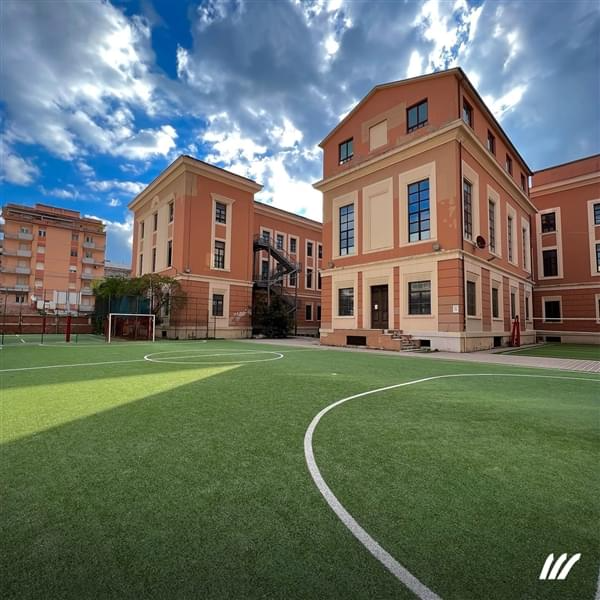What is the difference between turf and artificial grass?
The difference between turf and artificial grass goes beyond terminology—it comes down to purpose and material features. In short, turf is built for high-traffic sports and performance, while artificial grass is designed for landscaping, offering a more natural look with minimal upkeep.
In the next sections, we'll break down the key differences in terms of use, blade length, density, and overall appearance.

Table of contents:
- The characteristics of turf
- The characteristics of artificial grass
- Key difference between turf and artificial grass
- Advantages of turf
- Advantages of artificial grass
- Why choose Italgreen
The characteristics of turf
Turf is specifically designed for durability and performance in environments where heavy use is expected, such as football fields, soccer pitches, and playgrounds. Its fibers are shorter and denser, creating a tightly packed surface that reduces drag and enhances stability during fast movements.
Typically made from synthetic materials like polypropylene or polyethylene, turf delivers a harder, rougher surface with a low pile height. This design ensures players experience reliable footing, quick directional changes, and a surface that holds up under constant activity and wear. In short, turf prioritizes function and resilience over appearance.
The characteristics of artificial grass
Artificial grass, on the other hand, is created to replicate the look and feel of natural grass, making it ideal for residential yards, commercial landscaping, and decorative spaces. Its fibers are longer, softer, and often blended in multiple shades of green, giving it a realistic and visually appealing appearance.
Like turf, it is manufactured from durable synthetic fibers such as polyethylene, polypropylene, or nylon, but its design focuses on comfort and aesthetics rather than performance. With taller blades and a fuller texture, artificial grass provides a lush, evergreen surface that looks alive year-round while requiring far less maintenance than natural lawns.
Key difference between turf and artificial grass
When comparing the two surfaces, several aspects highlight the key differences between turf and artificial grass:
- Blade Length & Density: Turf features short, dense blades for durability, while artificial grass has longer, less dense blades that mimic natural grass.
- Appearance: Turf provides a uniform, functional look, whereas artificial grass is designed for a lush, realistic appearance.
- Texture: Turf tends to feel harder and rougher, while artificial grass is softer and more flexible to the touch.
- Use Case: Turf is best suited for sports fields and active play areas, while artificial grass is commonly used in landscaping, gardens, and decorative spaces.
Advantages of turf
Turf offers several advantages that make it a reliable choice for sports fields, playgrounds, and other high-traffic areas:
- Durability: withstands heavy foot traffic and weather conditions for years with minimal issues.
- Water Conservation: no need for regular watering; only occasional rinsing is required, supported by efficient drainage systems.
- Eco-Friendly: saves water, reduces pesticide use, and contributes to a more sustainable environment.
- Cost Efficiency: higher initial installation cost but long-term savings on water and lawn treatments.
- Pet-Friendly: short, sturdy fibers make it easy to clean and ideal for pets.
- Low Maintenance: no mowing or trimming required, making it effortless to maintain.
Advantages of artificial grass
Artificial grass also comes with unique benefits that make it especially appealing for residential and commercial landscaping:
- Increased Curb Appeal: available in various shades and textures to enhance outdoor aesthetics.
- Higher Resale Value: attractive and low-maintenance lawns appeal to prospective buyers.
- Durability: resistant to adverse weather, though less suited to heavy foot traffic compared to turf.
- Low Maintenance: no cutting, trimming, or watering needed.
- Allergen-Friendly: safe for allergy sufferers since it doesn’t trigger typical grass allergies.
- Kid-Friendly: soft texture reduces the risk of injury during play.
- UV-Resistant: manufactured to retain its vibrant color even under prolonged sun exposure.
Why choose Italgreen
At Italgreen, we stand out as more than just a supplier—we are also a trusted artificial grass and turf producer. This unique position allows us to control the entire production chain, guaranteeing the highest quality standards across all our products. By managing every stage, from design to delivery, we ensure reliability, durability, and performance you can trust.
But our role doesn’t stop once you’ve selected the type of lawn you need. We provide comprehensive installation support, supplying not only the mantle but also all auxiliary structures, including:
- Underfelts and anti-shock solutions
- Fences and lighting systems
- Irrigation equipment
- Specialized infills
- Drainage systems
With hundreds of artificial grass and turf installations worldwide, Italgreen has built a solid reputation backed by proven references and decades of expertise.
Discover our artificial grass solutions
